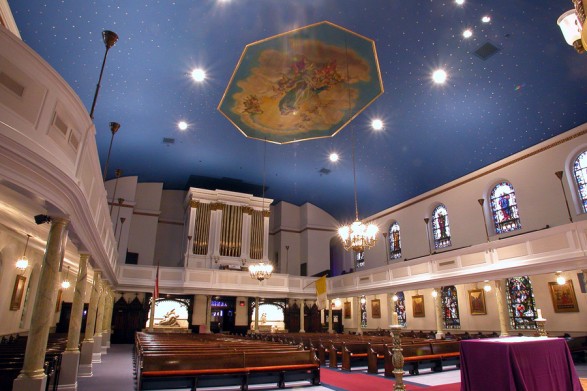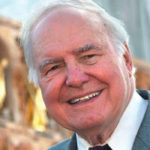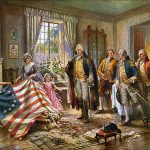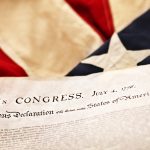On November 4, 1781, at Old St. Mary’s Church in Philadelphia’s old Society Hill, a solemn mass of thanksgiving was held in praise of the surrender of the British at Yorktown. Before the mass began, Washington, with his aides and generals, gathered round the altar and laid the defeated British colors on the altar steps, thanking almighty God for peace, and petitioning him for continued blessing and care.
It was to Catholic congregations like these that Washington wished “every spiritual and temporal felicity.” That warmth between the future president and Catholics was mutual; as Bishop John Carroll of Baltimore (later America’s first archbishop) said years later in his eulogy of Washington, “He was invested with a glory, that shed a lustre on all around him . . . with his [last] breath, as we may believe from knowing the ruling passion of his soul, he called to heaven to save his country.”
Some years later, at the time of the Civil War, the great American man of letters, Orestes Brownson, wrote happily that in America it was no discredit to a public man if he be a sincere and devoted Catholic. It was a proud thing for Brownson that Stephen Moylan, Charles Carroll, and Tadeusz Kościuszko—not to mention many of the ordinary volunteers who gave their lives in the late Civil War—were among the Catholics who figured integrally in our nation’s tale. His was the attitude of a great many patriotic Catholics down the generations in this country, and remains the attitude of many ordinary believers today. A growing number of Catholic thinkers, however, cannot appreciate our history in the same way, because, for them, America is rotten to the core thanks to a secular, individualist political philosophy, and an anti-Catholicism that, they suppose, is built in to its heart.
The academic debate about the nature of this country’s political philosophy, constitution, and origin, and whether these things are really inimical to faith and the common good, has recently arisen again here at Public Discourse. The purpose of this essay is not so much to take part on the familiar terms in that important debate about the nature of our founding and constitution. Rather, with Brownson’s help, it is to begin to understand that more fundamental constitution of our people, its organic constitution, and to show why that surely is worthwhile—and worth making the effort to retrieve and preserve.
Orestes Brownson and the Providential Constitution of the American People
Start your day with Public Discourse
Sign up and get our daily essays sent straight to your inbox.There is a great deal in Orestes Brownson’s writing that recommends itself to the thoughtful observer of American political history and life. What concerns us here is chiefly his conception of the “twofold” American constitution. For him, the constitution is not primarily a document but the actual way in which the people itself is constituted. The critics to whom I allude above often express a concern that our country was brought into being by a document formed on the basis of erroneous enlightenment principles. For Brownson, this is a misreading of our nation’s origins.
The written constitution did not materialize out of thin air. It was the expression and decision of an already constituted people, who codified and formalized the way they were to govern themselves. Brownson describes that pre-existing arrangement in this way:
The [organic] constitution is the intrinsic or inherent and actual constitution of the people or political community itself; that which makes the nation what it is, and distinguishes it from every other nation. . . [it] is not a theory, nor is it drawn up and established in accordance with any preconceived theory. What is theoretic in a constitution is unreal.
To Brownson’s way of thinking, some group within a given nation may attempt to impose a theoretic constitution on its people, but if what is proposed does not in fact match the way the people are actually constituted, doing so will require a great deal of force and will ultimately fail. Such was the effort of the French Revolution. The American constitution, by contrast, was not an imposition on the people but an expression of what already inhered in the nation’s traditions, laws, principles, and organization.
This points at the same reality observed by the early American Church itself—namely, that this country and its government were not born brand-new out of Enlightenment principles. They were, rather, an organic development of traditions stretching from Athens, through Rome, Jerusalem, London, and on to Philadelphia. Alexander Hamilton himself expressly agreed with Brownson’s later assessment. As Brownson wrote with regard to some expressions of James Madison’s:
What binds is the thing done, not the theory on which it was done, or on which the actors explained their work either to themselves or to others . . . [theory] may sometimes affect the phraseology they adopt, but forms no rule for interpreting their work. Their work was inspired by and accords with the historical facts in the case, and is authorized and explained by them.
John Adams once called the common political language of the founding an expression of the “harmonizing sentiment of the day.” That is, it was not so much a creature of the Enlightenment as an effort to extract what was valuable and practical from the whole tradition of political thought from Athens to the present, and to apply it to the given context of an already constituted people. As Brownson saw it, the United States was built as a development of a liberal tradition far older than and far different from the liberalism of Enlightenment Europe. As an heir to this great conversation, the American constitution seeks to unite in harmony the inviolability of the person and the priority of the public good—to strike a dialectical balance between liberty and order. This is why Brownson says that the United States is the most catholic of modern nations, because it is organized on real principles of human nature: principles that, being real, must also be catholic.
It is the nature of logos to reconcile all things in Himself, Brownson writes, and to take those things that seem to be in opposition and bring them into harmony. In a unique way, the American people is called by the same Word to reconcile the realities of freedom and order, unity and multiplicity. E pluribus unum; annuit coeptus. That we have often failed in this vocation does not obviate the original call.
Brownson, America, and Secularism
Even in those days, when the Church’s language about separation of church and state was stronger, Brownson saw no obstacle to Catholicism in the American system. The chief concerns with regard to the separation of church and state, as later expressed by Pope Leo XIII, were secularism and a subjugation of Church practice, affairs, and authority to the rule of civil lawmakers. Happily, in the United States, the principles of the government were not secular. Disestablishment is not tantamount to secularism. The Pope feared a government that might presume to make laws that made it authoritative in the practice of the church itself—precisely what the first amendment does not permit. It is also why Brownson observed: “except in the United States, the church is either held by the civil power in subjection, or treated as an enemy.”
Brownson wrote in the immediate wake of the Syllabus of Errors, and was well aware of its statements decrying separation of Church and state, but he aptly distinguished separation of establishment and separation of principle. What is problematic is that the principles of the state be separated from the principles of the church, or that the state operate in a way contrary to the truth about man—not that it operate without political union or association with the church. The condemnations of the Syllabus of Errors may seem, Brownson says, to “superficial and unthinking Americans” to condemn the American system itself, but, in fact, this would be to misunderstand the Church’s position even in its most headily stated form. “The Holy Father has condemned nothing . . . that is not at war with the American system itself,” he writes. What was rightly abjured by the Pope is “European Liberalism, which has no real affinity with American territorial democracy and real civil and religious freedom.”
For Brownson, then, the American system did not really constitute such a separation; it did have the advantage of avoiding the corrupting influences of power and wealth occasioned by the intermingling of ecclesiastical and secular authority. When these authorities mix, furthermore, little advantage can accrue to the mission of the Church. It was a truly Catholic principle Madison espoused when he wrote that faith mandated by government under the threat of force could not be fully pleasing to God. Since the Church proposes the faith through invitation and love, and does not impose it through the might of the magistrate, and since the mingling of these two authorities has had such deleterious and corrupting effects in history, it is a felicitous arrangement that the Church should find herself protected and free alongside a people constituted on fundamentally catholic principles.
Brownson calls the relation between church and state in this country the “normal relation”—“normal” in the sense of being normative. For it is only here, he says, that the political authorities of church and state may be held separate but fundamentally in accord. “The state here being organized in accordance with catholic principles, there can be no antagonism between it and the church . . . both are, in their respective spheres, developing and applying to practical life the one and the same Divine Idea.”
What would later come to be called “integralism,” Brownson saw, militates against the spirit of normal and healthy relations between the church and the state. For when the ecclesiastical and political authority are conjoined, the ecclesiastical becomes an organ and institution of the political. John Haldane, a prominent Catholic philosopher of our own day, has made a similar point: the conjoining of these two authorities tends always to a corruption of both. This is why, for Brownson, the most healthy and sane organization is the one that inheres already in America.
“May These United States Flourish.”
It is true that the United States has often strayed and is now straying further from the call Brownson identified in its organic constitution. These two facets of American life in tandem—that there is much worthwhile and much to decry in America today—make it important that we not abandon investment in our country’s good. We ought to heed the advice that Leo XIII gave to the French Church when they faced a less sympathetic system: “I urge you, accept the republic.” In America, a Catholic may go further, and pray with this country’s first, great archbishop that “these United States flourish in pure and undefiled religion, in morality, peace, union, liberty and the enjoyment of their excellent Constitution.”
Like the revolution through which the archbishop lived, our country is a complicated, very human affair. But, like the revolution, it also flashes with brilliance. This is a country flawed, truly, even from the beginning, but not irreparably, irretrievably so. Like Brownson, I cannot help, when touching the walls of Old North Church, looking over the misty vales of Gettysburg, or hearing mass in Old St. Mary’s—in the very spot where members of the Continental Congress had said their own prayers—feeling a warmth toward the whole, great American mess, and feeling more than a bit sorry for those who cannot feel it.














